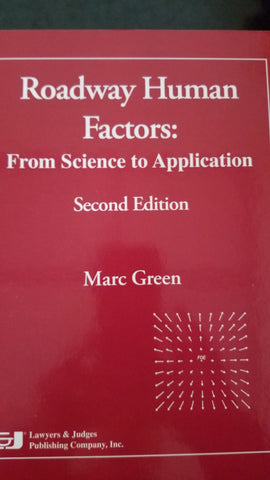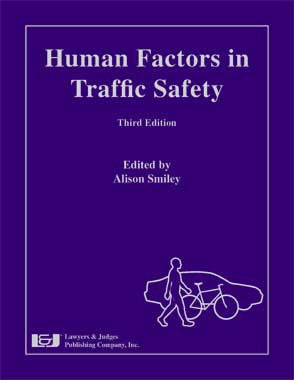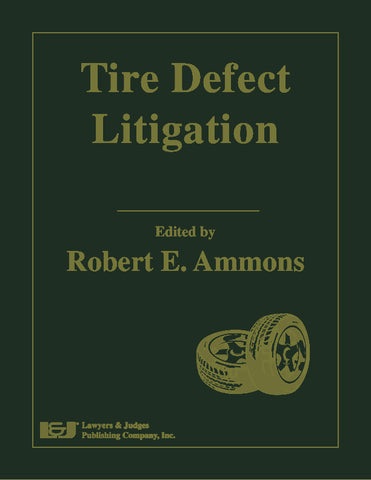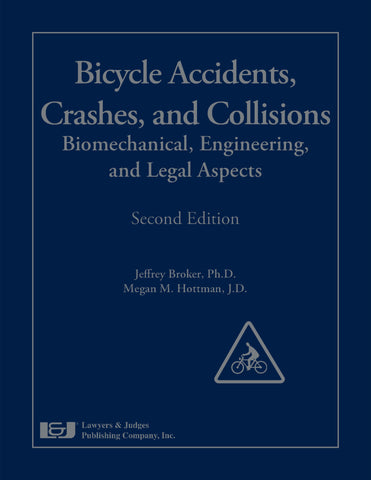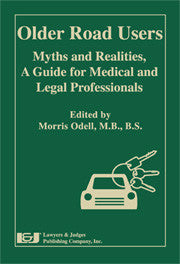
Older Road Users: Myths and Realities, A Guide for Medical and Legal Professionals
- Author: Morris Odell
- ISBN 10: 1933264705
- ISBN 13: 978-1933264707
- Copyright Date Ed: July 1, 2009
- Pages: 320 pages
- Binding Information: Hardcover
-
Size: 6 ✕ 9 Inches (US)
This book, one of the first of its kind, brings you state-of-the-art scientific information on the role of aging in driving behavior and motor vehicle accidents.
As our population ages, there will be an increase in the number of older drivers on the road. Those born during the post World War II baby boom are now reaching age 65 and are the first generation where driving has been a constant part of their lives. In countries such as Australia, the United States, and Canada - where driving is often a necessity - evaluation of driving ability and implications of potential accidents have become a concern.
This book teaches you about older drivers, their driving behaviors and actual risks versus perceived risks. While this study was conducted in Australia with predominantly Australian data, the findings are highly applicable to the United States and Canada.
This book gives you the most up-to-date information possible. It also explores the most common medical conditions that affect driving behavior in older people including neurological, cardiovascular, and other physical conditions; metabolic conditions such as diabetes and hypoglycemia; dementia; psychological issues; visual impairment; and the influence of multiple prescription drugs and alcohol. Extensive chapters are devoted to diabetes, dementia, visual impairment, and prescription drug and alcohol use, as these appear to be the most common causes of impairment of older drivers. A model management program for older drivers with diabetes is presented, with suggestions on how it might be used with other medical conditions.
You will also learn about the epidemiology of accidents involving older drivers including fatalities. This book also covers accidents involving older pedestrians and motor vehicles. It gives you an overview of common types of accidents involving older road users of all types and makes recommendations for managing and decreasing these accidents.
Of important concern is the evaluation of fitness of older drivers. This book teaches you about the different ways that older drivers are evaluated including the pros and cons associated with each. It also discusses mandatory age related driver testing. It also presents suggestions on implementation of driver evaluation programs as well as training for older drivers from an occupational therapy perspective.
This book also teaches you ways to help people manage the transition from driving to no longer being allowed to drive. It covers issues such as alternative modes of transportation, community and family support, and therapy for psychological issues associated with this transition.
This book is a must for your library if you work with older drivers in any capacity.
This book is also available as an eBook. Click here to purchase and download:
Topics Include:
- Accidents involving older drivers
- Accident risks of older drivers
- Licensing procedures
- Evaluation of fitness to drive
- Medical review of older drivers
- Vision and the older driver
- Dementia and cognitive problems
- Respiratory and sleep disorders
- Neurological conditions
- Effects of prescription drugs and alcohol
- Diabetes and metabolic disorders
- Older pedestrians
- Occupational therapy assessment and training of older drivers
- Transition from driving to no longer driving
Table of Contents
Chapter 1. Older Driver Crashes
Jim Langford
1.1 Introduction
1.2 Current Older Driver Crash Levels
A. Contribution to the Road Toll
B. Contribution to Hospital Admissions
C. Contribution to All Deaths
D. Conclusions
1.3 Do Older Drivers Have a Characteristic Crash Pattern?
A. Some Overseas Studies
B. Some Australian Studies
C. Conclusions
1.4 Are Older Drivers Likely to be Overly Responsible for Their Crashes?
A. The Difficulties in Attributing Crash Responsibility
B. Findings from the Research
C. Conclusions
1.5 Do Older Drivers Have a Heightened Crash Involvement?
A. Older Drivers’ High Crash Rates per Distance Driven
B. Frailty Bias
C. Limitations in the Exposure Measurements—Low Mileage Bias
D. Conclusions
1.6 Are Older Drivers a Heightened Crash Risk to Other Road Users?
A. Findings from the Research
B. Conclusions
1.7 Summary and Conclusions
Chapter 2. Managing Older Driver Crash Risk
Judith Charlton, Ph.D., Sjaanie Koppel, Ph.D., Jim Langford, and Justine Irving
2.1 Introduction
2.2 What Are the Current Older Driver Licensing Practices?
A. Australian Licensing Procedures
B. International Licensing Procedures
C. Summary
2.3 Is There Evidence for Universal Licence Testing, Based on Age, as an Effective Strategy for Managing Older Driver Risk?
A. Summary
2.4 Alternative Approaches to Licensing
A. Outline of the Proposed Australasian Model
B. Assessment of Functional Ability
C. Levels of Assessment of the Model Procedure
D. Use of Valid and Reliable Testing Instruments
E. Community Referral
F. Range of Outcome Options for Older Drivers
G. Establishment of a Case Officer Position
H. Assessment Undertaken by Government and Non-government Agencies
2.5 Use of Conditional Licences
2.6 Balancing Safety and Mobility
2.7 Self-regulation as a Means of Reducing Risk
A. Findings from Research on Self-regulatory Practices
2.8 Summary and Conclusions
Chapter 3. Vision and the Ageing Driver
Joanne M. Wood, Ph.D.
3.1 Introduction
3.2 Normal Age-Related Vision Changes
3.3 Visual Function, Ageing and Driving
A. Visual Acuity
B. Visual Fields
C. Contrast Sensitivity
D. Dynamic Visual Acuity
E. Monocular Vision
F. Useful Field of View
3.4 Ocular Diseases in Older Populations
A. Cataracts
B. Glaucoma
C. Age-Related Maculopathy
D. Diabetic Retinopathy
E. Stroke
3.5 Implications for Licensing
3.6 Conclusions
Chapter 4. Older Road Users—Effects of Dementia and Cognitive Changes
Peteris Darzins, BMBS, Ph.D. and Michel Bédard, Ph.D.
4.1 Introduction
4.2 Dementia and Other "Brain Failure Syndromes"
4.3 Pathology of the Dementing Processes
A. Alzheimer Dementia—Pathology
B. Vascular Dementia—Pathology
4.4 Dementia with Lewy Bodies—Pathology
4.5 Fronto-Temporal Dementia—Pathology
4.6 Clinical Features of the Dementing Illnesses
A. Alzheimer Dementia—Clinical Features
4.7 Vascular Dementia—Clinical Features
4.8 Mixed Dementia—Clinical Features
4.9 Dementia with Lewy Bodies—Clinical Features
4.10 Fronto-Temporal Dementia—Clinical Features
4.11 Other Dementing Illnesses
4.12 The Driving Task
4.13 Driving and Cognition
A. Stages of Alzheimer Dementia
B. Driving and Stage of Dementia Syndromes Other than Alzheimer Dementia
4.14 Incidence of Crashes in People with Dementia
4.15 Crash Patterns of Older Drivers
4.16 Driving Patterns of People with Cognitive Impairment
4.17 Differentiating "Safe" from "Unsafe" Drivers with Dementia
4.18 Management of Driving by People with Dementia
4.19 Conclusion
Chapter 5. Respiratory and Sleep Disorders in the Older Driver
Matthew T. Naughton, F.R.A.C.P.
5.1 Introduction
5.2 Respiratory Illnesses
A. Cigarette Smoking
B. Chronic Obstructive Pulmonary Disease
C. Pulmonary Fibrosis
D. Cough Syncope
E. Lung Cancer
F. Deep Venous Thrombosis and Pulmonary Emboli
G. Pneumothorax
H. Post Thoracotomy
I. Asthma
5.3 Sleep Disorders
A. Sleep Deprivation
B. Sleep Apnoea
5.4 Summary
Chapter 6. Driving and the Elderly: Neurological Conditions
Mark Cook, M.D.
6.1 Introduction
6.2 Stroke
6.3 Dementia
6.4 Parkinson’s Disease (PD)
6.5 Head Injury
6.6 Drugs
6.7 Epilepsy
6.8 Conclusions
Chapter 7. Road Safety Effects of Prescription Drugs in the Older Driver
Olaf H. Drummer, Ph.D.
7.1 Introduction
7.2 Terminology Used in Epidemiological Studies
7.3 Baseline Culpability
7.4 Alcohol
7.5 Drugs Other than Alcohol
A. Benzodiazepines
B. Anti-Depressants and Other Mood Altering Drugs
C. Anti-Diabetic Drugs
D. Anti-Coagulants
E. Opiates
F. Other Drugs
7.6 Conclusions
Chapter 8. Diabetes and the Older Road User
Trisha Dunning, Ph.D.
8.1 Diabetes
8.2 Incidence of Traffic Crashes in Older People with Diabetes
8.3 Effects on Driving Ability Related to Diabetes
8.4 Functional Impairment and Disability
A. Physical
B. Depression and Cognitive Functioning
C. Hyperglycaemia <brD. Hypoglycaemia
8.5 Self-Care Knowledge and Behaviours
8.6 Improving Driving Safety in Older People with Diabetes
8.7 Summary
Chapter 9. Walking for Older Road Users: A Safe Alternative to the Car?
Jennie Oxley, Ph.D.
9.1 Introduction
9.2 Walking: Benefits and Drawbacks
9.3 Crash Types
9.4 Why the Over-Involvement of Older Adults in Pedestrian Crashes?
A. Vulnerability
B. Pedestrian Behaviour
C. Vehicle Design
D. The Road and Traffic Environment
9.5 Achieving Safe Pedestrian Environments
9.6 Safer Road Users
9.7 Safer Vehicles
9.8 Safer Roads
A. Moderating Vehicle Speeds
B. Separation of Vehicles and Pedestrians
C. Simplification
9.9 Summary and Conclusions
Chapter 10. Medical Review of Older Road Users
Morris Odell, M.B., B.S.
10.1 Introduction
10.2 Licensing Guidelines
10.3 The Role of Health Professionals
10.4 Medical Assessment of Fitness to Drive
10.5 Principles of Medical Driver Assessment
A. History
B. Examination
C. Investigations
D. Specialist Assessment
10.6 Driving Restrictions and Licence Conditions
10.7 Conclusion
Chapter 11. Assessing Older Drivers with Health-Related Problems: An Occupational Therapy Approach
Carolyn Unsworth, Ph.D.
11.1 Introduction
11.2 Who Are OT Driver Assessors and What Do They Do?
11.3 Occupational Therapy Driver Assessment Processes and Reporting: Systems in Australia (Victoria), the U.S., U.K. and Sweden 241
11.4 Profile of Older Drivers Evaluated by Occupational Therapists
11.5 The Skills Needed to Be a Safe Driver, and the Impact of Age on These Skills
11.6 Off-Road Driver Assessment for Older Adults
A. Driving Simulators
11.7 On-Road Driver Assessment for Older Adults
11.8 Rehabilitation and Strategies to Maintain Driving Independence
11.9 Future Directions in Driver Assessment and Rehabilitation Research
11.10 Summary and Conclusion
Chapter 12. Older Drivers Killed on the Road—Analysis of Data from Coroner’s Files
Morris Odell, M.B., B.S., and Olaf H. Drummer, Ph.D.
12.1 Background
12.2 Method
12.3 Results
A. Alcohol and Drugs
B. Medical Diseases
C. Culpability Analysis
12.4 Discussion
Chapter 13. The End of Driving
Nadia Mullen, Ph.D. and Michel Bédard, Ph.D.
13.1 The End of Driving
13.2 Depressive Symptoms
13.3 Impact on Daily Activities
13.4 Impact on Others
13.5 Positive Effects
13.6 Moderating Factors
13.7 Managing Transport Needs
13.8 Preparation
13.9 Conclusion

